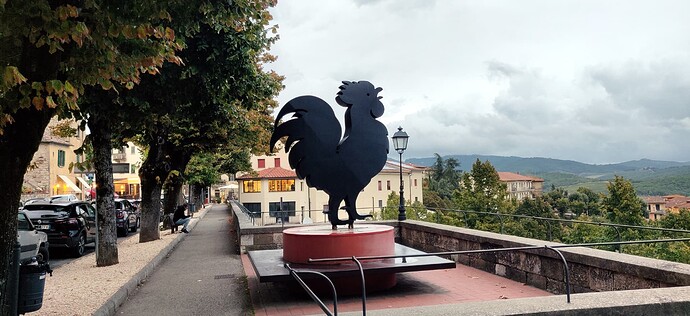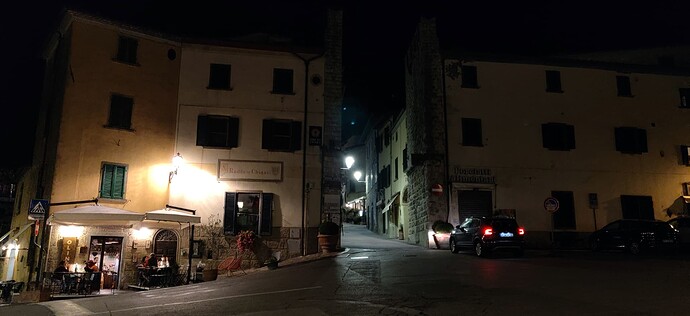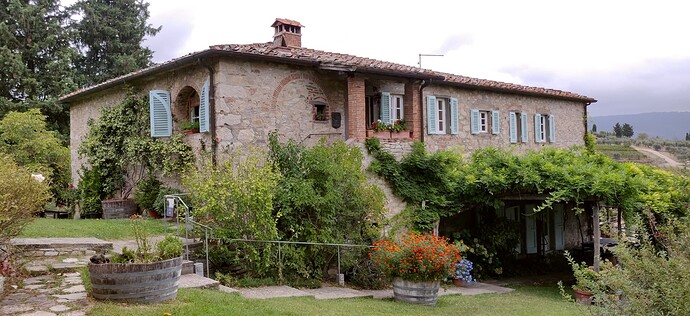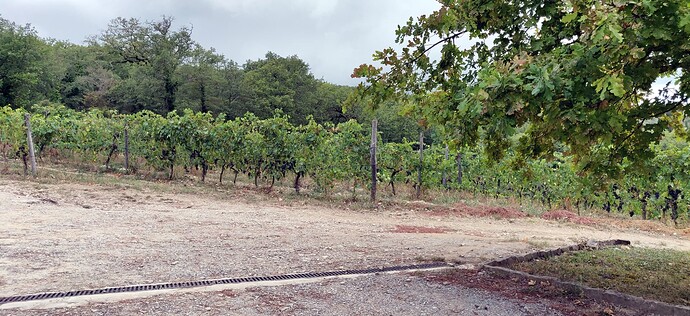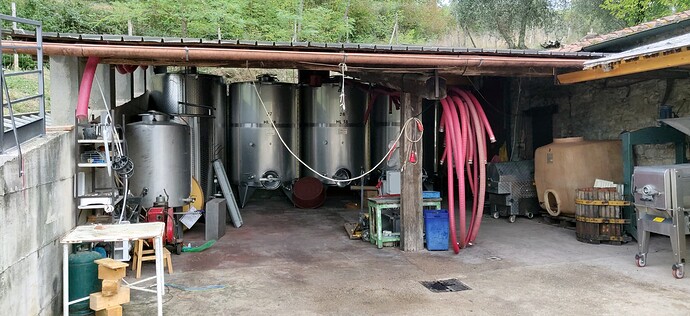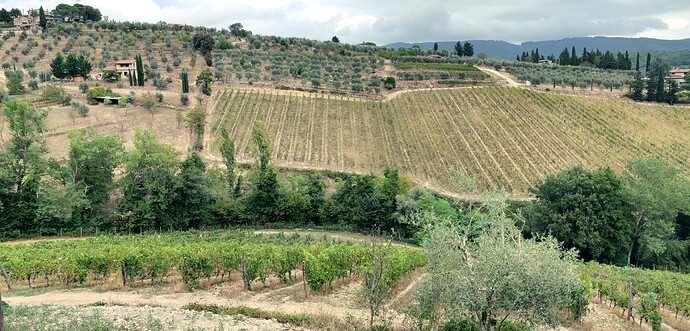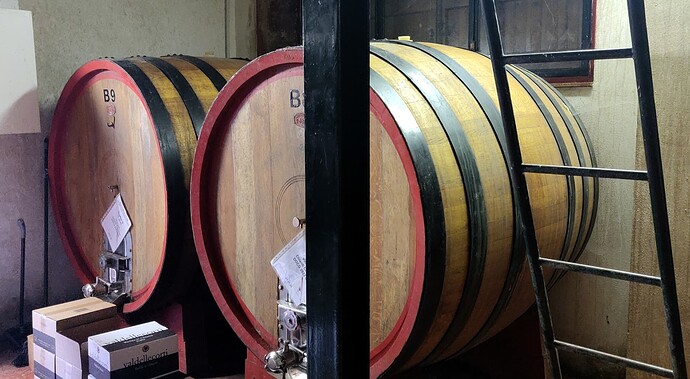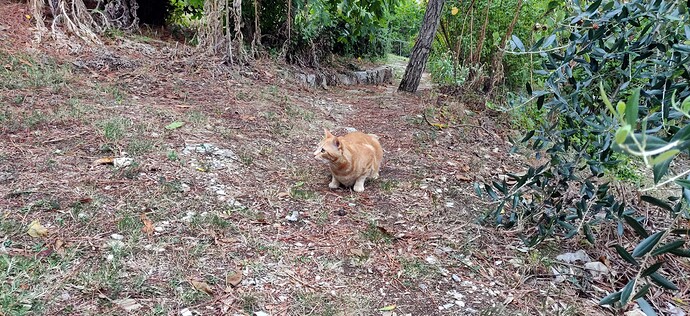After our visit at Montenidoli we headed from San Gimignano - northwest from Siena - to Radda in Chianti - northeast from Siena. After about an hour’s drive on small, quiet country roads that were constantly winding up and down surprisingly steep hills, we arrived at Radda, one of the three comunes (along with Castellina and Gaiole) that made up the original demarcation of the Chianti region in 1716.
The main street and boulevard at Radda:
Although Chianti is a very hilly region as a whole, Radda is known for its very, very steep hills and overall high elevation, which make it a very cool corner of Chianti. The few lower-lying parts are just below 400 m above sea level, whereas some vineyards climb up to 500 m asl and above - also the town of Radda itself sits atop a hill, more than 500 m above sea level. To get some sense of the steepness of the hills: in many parts around Radda the lowest parts of the hill (at around 400 m asl) are just some 200 m away from the highest parts (at over 500 m asl). That translates to inclination of around 50% (or 26°)!
Radda in the evening:
Anyways, we didn’t stop in Radda then, but instead drove through the town straight to our lodgings, to agriturismo at Fattoria Poggerino, one of the great local producers located a few kilometers northeast from Radda, right across the street from Montevertine. (And, yes, we tried to ask for a possibility to visit Montevertine, but they declined - even when we tried to ask through their Finnish importer. Only now I’ve learned that they really don’t accept any visits anymore, unless you have an “inside person” with you - or if you happen to be one yourself. I know I wasn’t!)
Almost immediately after we had managed to move our stuff to our room at Poggerino’s agriturismo (fortunately I didn’t have much to carry since my luggage never arrived!), we headed back to the direction of Radda and drove across the town to Val delle Corti, a producer right outside the southwestern edge of Radda.
Val delle Corti
The history of this estate goes back to 1974, when Giorgio Bianchi and his family moved from Milan to Radda so that Giorgio could fulfill his dream of living in the countryside, making wine. Giorgio and his wife Eli rebuilt the old, dilapidated farmhouse, replanted the vineyards and built a small cantina next to the farmhouse.
The original Sangiovese vineyard, planted in 1974:
Unfortunately Giorgio passed away in 1999, so his son Roberto returned back to Radda where he had spent his childhood to keep the winery up and running.
Roberto met us late in the afternoon, telling he might not have much time for us as he had business to attend to early next morning - yet he seemed to have more than enough time for us, presenting us their vineyards, wines and the cantina like we had all the time in the world!
Roberto told us that moving to Radda to make wine was a risky move in the 1970’s, since the place was - and to some extent, still is - a relatively cool place. The local style of Chianti Classico is very acid-driven and can be quite lean, even austere - that is something people didn’t look for back then. Some don’t even today! Furthermore, Radda was a very rural place back then as well. While it is still located off the beaten path, it has evolved quite a lot since; today it is a lovely small town buzzing with tourists and sporting about a dozen restaurants and even one craft brewery!
All the Val delle Corti vineyards are located on the hillside west from Radda, on the same east-facing hillside. This means that the vineyards are met with the morning sun but never bathe in the long, warm evening sunlight. In the past this meant it was very difficult to get the grapes ripen fully and cooler vintages could be disastrous. However, Roberto told us that this aspect had turned to their benefit on this side of millennium - they normally don’t have to worry about ripening the grapes, but even in hot vintages their grapes don’t seem to lose acidity and freshness - something that producers with warmer vineyards might suffer from!
Roberto told us that when he returned to the family winery, he didn’t have much experience or knowledge how to farm grapevines or how to make wine. However, with the assistance of Sean O’Callaghan (of Riecine and Tenuta di Carleone fame) he started to learn the ropes. Roberto spoke of O’Callaghan with great respect, telling us how O’Callaghan never told how he should or should not make wines, only encouraging him to experiment and see how the wines would turn out. At the moment Roberto seemed to be very happy with both his vineyards and his wines, even if he continued by adding that he also liked to experiment in search for even higher quality.
The small cantina - basically size-wise, this is a garagiste operation:
In vineyard size, Val delle Corti is rather small - the estate encompasses 9 hectares, of which 6 ha are estate vineyards and 3 ha are leased, meaning that annual production is around 40,000 bottles. The vineyards are farmed according to organic and biodynamic principles and you could really see it - from the veranda we could see the green, verdant vineyards extending downhill from the vineyard all the way down to the valley bottom. The difference between these vineyards and the straggly, tan-colored on the opposite side of the valley was huge. Even more so, when Roberto told us how the vineyards on the lower part of their side of the hill were planted at the same time as the vineyards on the opposing hillside!
The wines are made more or less in a traditional fashion (although some producers seemed to think Roberto as more of a postmodern winemaker, seeing how he made some of his wines with some carbonic maceration - just as Sean O’Callaghan!). The wines are made in a rather non-interventionist fashion, ie. the must is fermented spontaneously with indigenous yeasts and the wines are aged in old, neutral oak barrels. Most of the wines age in botti casks, but also some old barriques are employed as well.
In total Val delle Corti makes six wines:
- Rosé Scuro - a saignée rosé made when a portion of Chianti Classico is bled off
- Lo Straniero - the entry-level wine, made from Sangiovese with some Merlot, aged in stainless steel
- On y danse - the “modernist” vino rosso, mainly Cabernet Sauvignon and Merlot, aged in tonneaux
- Chianti Classico - the traditionalist wine with a twist: this is mainly Sangiovese with some Canaiolo. A portion of the wine is made with - as Roberto calls it - “the Piedmontese method”, meaning that some of the fruit does not get destemmed, but is instead vinified in whole bunches gently with a submerged cap, resulting in carbonic maceration. Roberto told us how this both helps to tame the naturally high acidity and also add some fine aromatics to the wine.
- Chianti Classico Riserva - the true traditionalist: made exclusively with Sangiovese grapes sourced from the original vineyard planted in 1974 next to the winery.
- Extra - basically the exact same wine as CC Riserva, but made only in vintages Roberto deems suitable. A portion of the grapes is not harvested at one go, but left to ripen for another two to three weeks. As the production of this wine is very small, it is not aged in botti but in smaller-format oak barrels.
Of these, we tasted the following:
-
2019 Val delle Corti Chianti Classico - Italy, Tuscany, Chianti, Chianti Classico DOCG (22.9.2023)
A blend of Sangiovese (95%) and Canaiolo (5%) from the organically farmed 7-30 yo vineyards on an east-facing slope in Radda in Chianti. The 2019 vintage was even and at times quite hot with intermittent rains keeping the water reserves in check.The grapes were picked at good ripeness in mid-October. 70% of the fruit is destemmed. The wine is fermented spontaneously and macerated with the skins for three weeks in stainless steel tanks and open-top vats, whereas the 30% of the whole-bunch fruit undergoes carbonic maceration and is kept in contact with the wine for a remarkable four months. Aged for 24 months in old, neutral Slavonian oak botti casks ranging from 2000 to 3000 liters. Bottled in March 2022. 13,5% alcohol.
Pale, vibrant and translucent garnet color - slightly lighter than one might expect from a Chianti Classico. The nose feels ripe, vibrant and wonderfully fragrant with somewhat dark-toned and sweetly-fruited aromas of ripe black cherries, some earthy tones, a little bit of fresh dark berries, light fragrant floral notes of violets, a hint of brambly raspberry and a herby touch of sweet, leafy greenness. The wine feels ripe, firm and sinewy on the palate with a quite full body and remarkably intense flavors of sour cherries and brambly raspberries, some crunchy notes of tart red plums, a little bit of stony minerality, light sweeter notes of dark fruits, a hint of tobacco and a touch of earth. The overall feel is wonderfully structured, thanks to the bright and crunchy acidity and the firm, rather grippy tannins. The finish is harmonious silky yet very firm and grippy with a long, dark-toned and rather dry aftertaste of tart lingonberries, fresh black cherries and sour cherry bitterness, some stony mineral notes, a little bit of brambly black raspberry, light earthy tones, a hint of blood and a touch of tobacco.
A wonderfully firm and intense yet still relatively light and airy Chianti Classico that combines ripeness and freshness so wonderfully together. Tasting the wine next to the 2020 vintage, this 2019 showed a bit more ripeness, coming across as a bit darker-toned and slightly bigger in character, resulting in a subtly softer and sweeter overall character - even if both the wines were remarkably high in acidity and I think this 2019 had sturdier tannic structure than the 2020! The overall style with these Val delle Corti CCs is simply exquisite: they are remarkably fresh, bright and acid-driven - even in the context of Chianti Classico - with beautifully fragrant and perfumed aromatics and stunning intensity of flavors. Normally I'd prefer a lighter, more red-toned vintage over a darker-toned one showing more ripeness, but this time both these wines were so remarkably fresh, firm and focused that it's impossible for me to put either in front of the other. While these vintages were somewhat different from each other, they are both fantastic wines that are drinking quite wonderfully already now - although I'd say it will take at least a handful of years more before these wines reach their optimum drinking window. A great purchase at 23€.
(93 points) -
2020 Val delle Corti Chianti Classico - Italy, Tuscany, Chianti, Chianti Classico DOCG (22.9.2023)
A blend of Sangiovese (95%) and Canaiolo (5%) from the organically farmed 7-30 yo vineyards on an east-facing slope in Radda in Chianti. The 2020 vintage was very hot with very little rain - until close to the harvest, when heavy rains caused some concern regarding the quality. However, with good selection the winery was left with ripe, thick-skinned grapes with relatively little of high-quality juice. 70% of the fruit is destemmed. The wine is fermented spontaneously and macerated with the skins for three weeks in stainless steel tanks and open-top vats, whereas the 30% of the whole-bunch fruit undergoes carbonic maceration and is kept in contact with the wine for a remarkable four months. Aged for 24 months in old, neutral Slavonian oak botti casks ranging from 2000 to 3000 liters. Bottled in February 2023. 13,5% alcohol.
Pale, vibrant and translucent garnet color - slightly lighter than one might expect from a Chianti Classico. The nose feels wonderfully fragrant and perfumed with expressive aromas of cherries and strawberries, some floral notes of violets and orange blossom, light sweet nuances of raspberry marmalade, a little bit of tobacco and a hint of blood orange. The wine feels wonderfully clean, juicy and precise on the palate with a medium body and intense, dry flavors of sour cherries and tart lingonberries, some crunchy notes of cranberries, a little bit of ferrous blood, light sweeter nuances of ripe raspberries and wild strawberries, a perfumed hint of floral character and a touch of pipe tobacco. The overall feel is enjoyably sinewy and structured, thanks to the bright, high acidity and moderately grippy medium-plus tannins that slowly pile up on the gums. The finish is long, dry and moderately grippy with a fresh and crunchy aftertaste of tart lingonberries and sour cherry bitterness, some stony mineral tones, a little bit of tobacco, light ferrous notes of blood, a hint of ripe cranberry and a touch of wild strawberry.
A delicious, wonderfully fragrant and so very elegant Sangiovese-driven wine that packs great sense of intensity, laser-sharp precision and quite a bit of tannic grip, but at the same time comes across as relatively light on its feet for a Chianti Classico. I guess the portion that undergoes carbonic maceration contributes to the wonderfully perfumed overall character, because these Val delle Corti Chianti Classicos seem to be more floral than their Riserva version, which doesn't see any carbonic. However, the carbonic maceration doesn't really lend any bubblegum-y Beaujolais Nouveau aromatics to the wine, but instead makes the wine feel somewhat similar to, say, a perfumed Barbaresco that sees extended skin contact after the fermentation. This wine is very much open for business right now, but with its impressive structure and intensity of flavors, I can see it easily improving for years more. An excellent purchase at 20€.
(93 points) -
2019 Val delle Corti Chianti Classico Riserva - Italy, Tuscany, Chianti, Chianti Classico DOCG (22.9.2023)
100% organically farmed Sangiovese sourced from a single vineyard planted in 1974 on an east-facing slope right next to the winery in Radda in Chianti. The 2019 vintage was even and at times quite hot with intermittent rains keeping the water reserves in check. The grapes were picked at good ripeness in mid-October and fully destemmed. The wine is fermented spontaneously and macerated with the skins for three weeks in stainless steel tanks and open-top oak tonneaux. Aged for 30 months in old, neutral barriques and 500-liter tonneaux. Bottled in July 2022. 13,5% alcohol.
Moderately pale and very translucent cherry-red color with a slightly evolved pomegranate hue. The nose feels seductive but also slightly reduced with slightly sweet, dark-toned aromas of juicy black cherries, some ferrous notes of blood, a little bit of fresh red plum, light candied primary notes, a hint of brambly black raspberry, a rubbery touch of reduction and a woody whiff of old oak spice. The wine is stern, quite tough and pretty dead-serious on the palate with a rather full body and ripe yet dry and intense flavors of sour cherries and tart lingonberries, some earthy and gravelly tones, a little bit of tobacco, light ferrous notes of blood, a hint of old leather and a reductive touch of rubbery character. The wine is quite muscular and structure-driven with its high acidity and assertive, grippy tannins. The finish is long, stern and tannic with a dry and very intense aftertaste of sour cherries, some gravelly mineral tones, a little bit of tobacco, light brambly notes of raspberries and fresh blackberries, a sweeter hint of ripe black cherry and a touch of old leather.
A very stern, structure-driven and classically styled Chianti Classico built in a very pure, unadulterated old-school style. This is, above all, a food wine - just as a good CC Riserva should be. However, based in its slightly reductive nature and subtly candied primary notes of fermentation esters in the nose, the wine is still painfully young and not yet ready. I'd say this wine needs at least another 3-5 years before it starts to reach its optimal drinking window, but most likely the wine call for another decade or two of aging - possibly even longer - before it reaches its peak. This is a super-serious wine that is built to age, not to impress. A fantastic example from the lighter yet still very structure-driven end of old-school Chianti Classico that will only get better with further aging. Very highly recommended. Great value for the quality at 35€.
(94 points) -
2019 Val delle Corti Extra - Italy, Tuscany, Toscana IGT (22.9.2023)
Extra is technically the exact same wine as Val delle Corti's Chianti Classico Riserva, only made with grapes harvested much later in the season and only in vintages the winery deems suitable for the production of Extra. The wine is 100% organically farmed Sangiovese sourced from a single vineyard planted in 1974 on an east-facing slope right next to the winery in Radda in Chianti. The 2019 vintage was even and at times quite hot with intermittent rains keeping the water reserves in check. The grapes were picked at good ripeness in late October and fully destemmed. The wine is fermented spontaneously and macerated with the skins for three weeks in stainless steel tanks and open-top oak tonneaux. Aged for 36 months in old, neutral barriques and 500-liter tonneaux. Bottled unfined and unfiltered. 14% alcohol.
Moderately pale and very translucent cherry-red color with a slightly evolved pomegranate hue. The nose feels rich, expressive and sweet-toned with lush, slightly lifted aromas of cherry marmalade and strawberries, some bilberry tones, a little bit of balsamic VA, light notes of leather, a hint of fresh black cherry and a touch of tobacco. The wine feels concentrated and silky smooth yet quite firm on the palate with a full body and intense flavors of strawberries, some sour cherry bitterness, a little bit of brambly raspberry, light notes of tobacco and old leather, a hint of balsamic VA and a savory touch of meaty umami. At first it seems the structure relies mostly on the high acidity as the ample yet ripe tannins seem to contribute more to the chewy texture than to the structure, but the tannic grip hits you slowly and late. The finish is long, quite grippy and rather powerful with a ripe, intense aftertaste of strawberries and slightly wizened red cherries, some sour cherry bitterness, a little bit of balsamic VA, light red-toned notes of strawberries and ripe red plums, a hint of tobacco and a sweet touch of raspberry marmalade.
A wine quite similar yet surprisingly different from the Val delle Corti CC Riserva. You can taste they are both cut from the same cloth, but whereas the Riserva bottling is very much Radda with its bone-dry, dead-serious and quite tough overall character, this wine would be at home in some warmer parts of Chianti Classico - like Panzano or Castelnuovo Berardenga - due to its sweeter and sunnier flavors that mask away some of the wine's impressive structure, making it initially feel softer than it actually is. While an impressive, balanced and wonderfully structured wine in its own right, I must admit I liked the lighter, less impactful but more fragrant and elegant Chianti Classicos of Val delle Corti more. Nevertheless, this is a superb wine that is starting to drink wonderfully right now, but most likely will continue to evolve and improve for a decade and even more. Priced more or less according to its quality at 50€.
(92 points)
Posted from CellarTracker
This fine little fella followed us around when we were checking out the cantina: